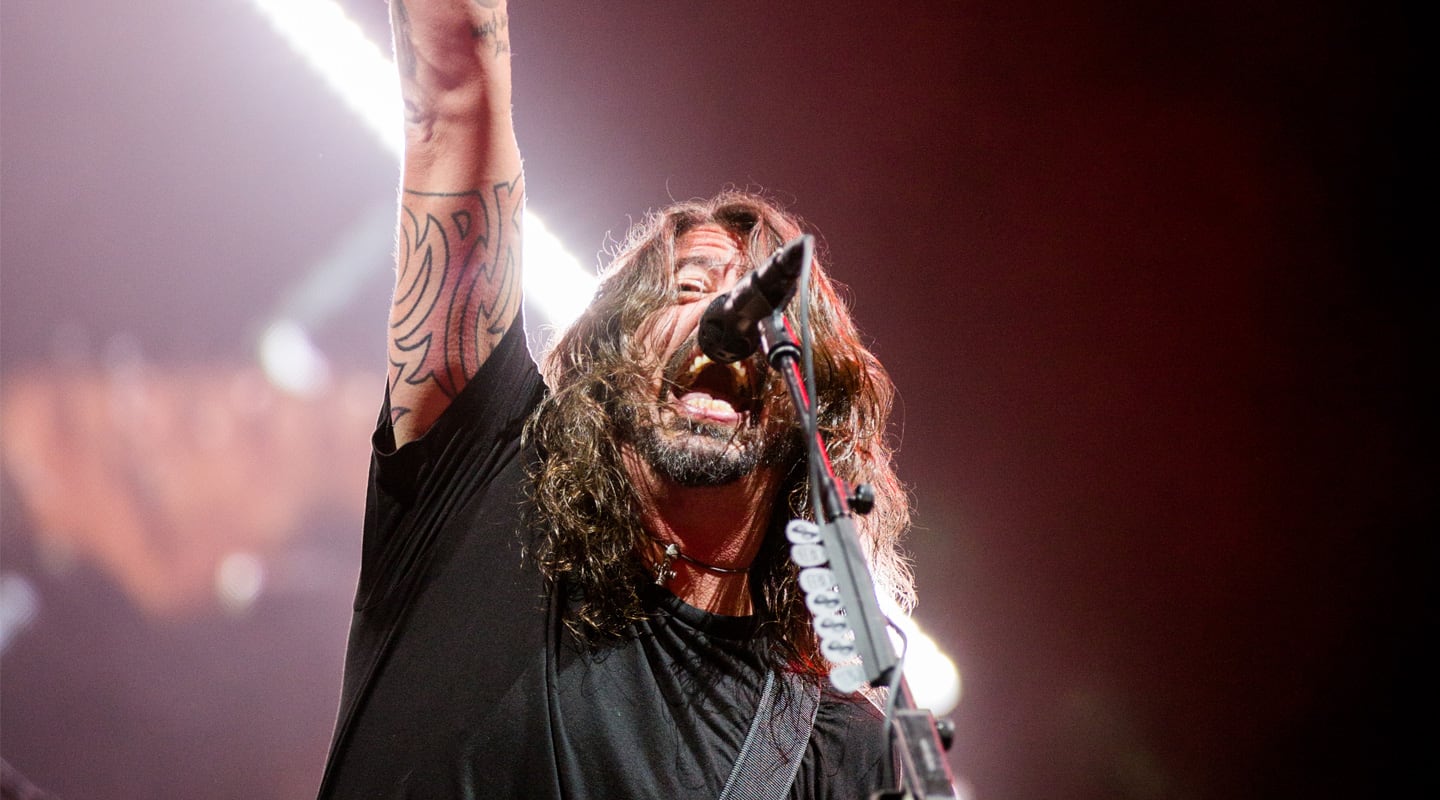
Thunderous Grohl
250 speakers, an ‘analogue-sounding’ Yamaha digital console, prototype Royer ribbons, and no snapshots. How a massive Foo Fighters stadium show comes together.
Show Photos: Brett Schewitz
“Just so you know,” says Dave Grohl, taking in the crowd from the tip of the catwalk at Etihad Stadium, “This is a big Foo Fighters show.”
With over 45,000 rock fans in attendance, Grohl isn’t telling fibs, but at this stage pretty much all Foo Fighters shows are big. They’ve performed in stadiums during their last two Australian tours, including Etihad in 2015.
The shows aren’t just big either, they’re long; Springsteen-rivalling long. For almost three hours, Grohl and co. sung, screamed, smashed and plucked their way through an entire collection of hits, including a smattering of covers. There’s no way you could walk away from a Foo Fighters show and not be impressed. There’s the rock spectacle of it, the generation-spanning hits, the stadium-wide singalongs, but at its core, you’re just left wondering how the heck he does it? How does he scream through the breathless string of lines in Monkey Wrench’s bridge and still have a voice, let alone carry on for three hours!
FOH engineer Bryan Worthen knows the highs and lows of a Foo Fighters show rest almost entirely on Grohl’s shoulders. “Dave is the main focus. On the records, Dave’s vocal has lots of effects on it, but live, people just want to hear his voice,” explained Worthen. “The way they play every song is based off how Dave is playing — the timing, the feeling.” Surprisingly — given there are three guitarists to choose from — Worthen says Dave’s guitar is also the loudest for 90% of the show.
YAMAHA BRAIN RETRAIN
Worthen has been with the Foo Fighters since the One By One tour, 16 years ago. Back then, it was clubs and theatres, with a few small arenas in Europe. Much of the crew has remained since then. The longest-standing member being monitor engineer, Ian Beveridge, who’s been with Grohl since Nirvana’s Nevermind tour. The crew has grown up with the band, making for a well-oiled show. However, Worthen steers clear of snapshots, preferring to use his digital console in a more analogue manner.
Early last year, he switched to a Yamaha Rivage PM10 console, after a succession of Digicos. “It’s been a long time since I was on a Yamaha,” said Worthen. “Not since the PM4000.” His last analogue console was the Midas XL4, and when management made the decision around 2005 to downsize the footprint and weight of his rig, Worthen chose Digico consoles because their channel strips were the most “visually analogue”. Over the next decade he went through the D5, SD7, and SD5. Visually analogue wasn’t enough though, and Worthen went looking for something that sounded more like an analogue console. When Beveridge decided he was going back to Yamaha from Midas at the monitor position, Worthen thought he should take a look at it too. “I went and played with it, out of curiosity,” he said. “It was cool and sounded great with a multi-track, but I had to hear it with my band. When I did, I knew it was the one.”
Although the PM10’s surface is quite direct, Worthen has also started weening himself off the need to see every channel at all times. “I can drift off and look at a compressor, which is nice. It’s retraining my brain to not freak out.” He still carries two Avalon VT737 channel strips for vocals, but doesn’t use them. “They’re a crutch. When I was using the Digico boards I couldn’t live without my 737s,” he said. “When I began using the PM10 I started with them in, but in rehearsals I realised I didn’t need them anymore. I left them there in case I freaked out, but they’re going away.”
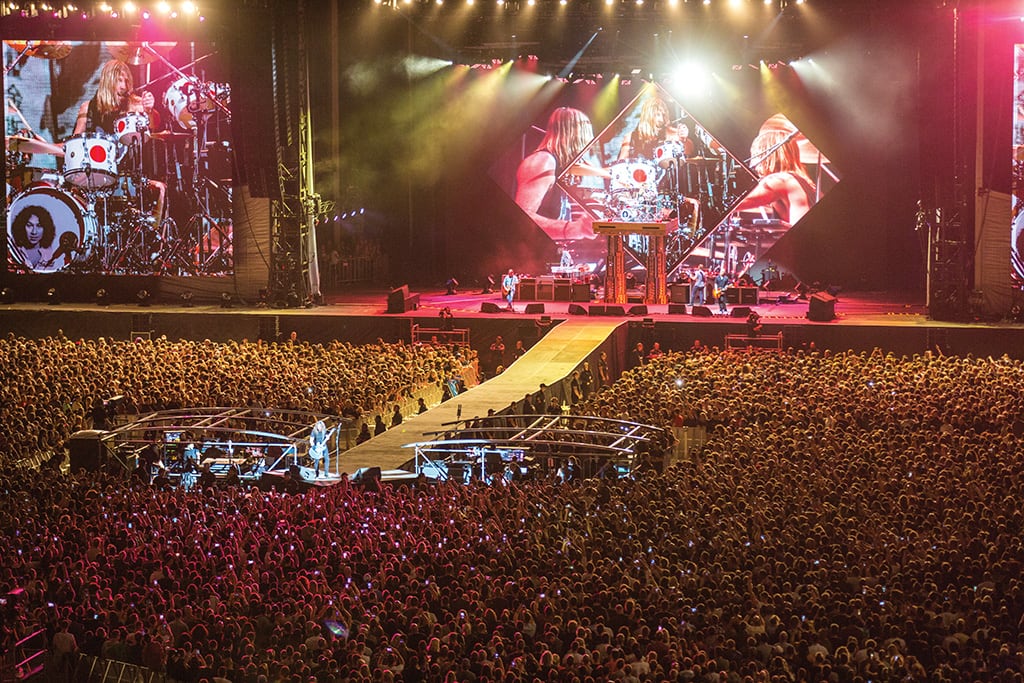

KICKING OFF AT STUDIO 606
Worthen’s tour schedule usually kicks off just before the band starts doing promo — television or small club shows. This year, they all decamped to a room in the Foo Fighters’ own Studio 606. “I take the back room and Ian will go in the iso room with monitor world,” described Worthen. “It gives us a starting plan. I’ve done it so many times, and I know what I’m listening to through the L-Acoustics 108s (coaxial powered speakers) that I can generally go into any show with minor changes.”
The stadium rig is pretty spectacular, with 250 L-Acoustics boxes [see PA sidebar] but Worthen keeps his gear and mix approach fairly simple.
The whole show occupies 54 channels, including the runway portion. Despite the length of the show, and operating one of the newest digital consoles, Worthen doesn’t use any snapshots throughout the entire gig. He also stays very light on the effects. He can count the number of effects he uses on one hand. There’s the SPX distortion patch he uses for Dave’s vocal on Run, with a long delay. The same distortion appears on La Dee Da with a verb on the distortion for a rockabilly sound. The only other occasion delay appears on Grohl’s vocals is in Arrows. He also has a short slap delay on drummer Taylor Hawkin’s lead vocal for Sunday Rain, and a H3000 patch for the backup vocalists. “The records aren’t dry like my mix, but why are you going to add a bunch of reverb to a massive reverb chamber like a stadium?” questioned Worthen. “It’s just added noise. Instead I EQ everything so I don’t have to add effects to make it sound big. I also run my gates open and light. That way when he hits it, it sounds like a natural drum that rings out — to a point… I don’t want it to warble.”

AXE BATTLE
Even with EQ, getting three guitars to fit isn’t an easy task, especially when they’re set to stun. “You have to create a lot of distinction between the three different guitars,” said Worthen. “It’s a battle of volume on stage, which makes it harder on me. It comes to me offstage as a wall of sound. Each guy has two cabinets, Pat [Smear] has two gold Soldano cabinets, Dave has one on each side of the drum riser, Shifty [Chris Schiflett] has two Friedmans, and two Voxes that get played on about four songs in the set.”
Over the years, Worthen says getting the guitars right has been a battle. Recently, he decided to change up the entire chain. Firstly, there was the shift to the Yamaha PM10. “I battle them less with this console than I have with others,” he said. “Right off the bat my guitar actually sounded like a guitar and I didn’t have to work hard at it. Previously, I had to EQ the snot out of it, and I don’t like doing that to anything.”
The second big change was moving almost entirely to Royer ribbon mics. Each guitarist has a single ribbon on his cab, with the exception of a Sennheiser 609 on Schiflett’s second Friedman.
“I was using the black, active Royer 101 on Godsmack,” said Worthen. “In rehearsals, Ian and I were talking about the fix for these guitars being to find the right microphone. We’d both been struggling for years with guitars. I told him about using the Royers and f**cking loving them! He said, ‘let’s try it.’ So we got a couple of loaners and put them in front of the cabinet. Ian was like, ‘These things are amazing!’ Then we went to Royer via our new guitar tech, who hit up his friend at Royer. They asked us if we wanted to try some new prototypes and do some R&D on them. They’ve been great.”
Worthen uses the natural frequency response of the microphones to create tonal separation, combined with a bit of high-end shelving. On the left, Schiflett’s guitar tone combines a prototype Royer R-10 [see our review of the final product this issue] with a bit of the top end shelved down, using the Sennheiser e609 dynamic for more presence. Grohl’s is another prototype R-10 with the top end boosted, while Smear has the more standard R-121 passive ribbon, set completely flat. “The different microphone makes him a little bit darker, so I don’t have to have the battle of high end,” explained Worthen.
While he doesn’t run a whole lot in stereo, each of the guitars is duplicated on another channel. Worthen then delays the second channel by about 8ms to spread them out. For Schifflet and Smear, both channels are panned hard left and hard right, with the delayed signal on the opposite side to their stage sound. “It makes it a little easier to separate Pat and Chris,” explained Worthen. With Grohl being in the centre, and the focus of the show, his guitar is panned a soft left/right, about 40% each way.
“The reason we use the drum mics we do is because our mics get a lot of abuse,” said Worthen. “Especially during load out. People step on them, they get tossed on the floor and kicked around. The Royers don’t get abused as much, because whoever strikes the mics gets to those first. Still, as far as travelling goes, they’ve been rock solid. People said the Royer R-101s vibrate apart, but I never experienced that. These prototypes are German-level engineering; built like little tanks. There’s nothing fragile about them at all.”

SOFTLY SCREAMING
Worthen spends a lot of the night manhandling guitars, especially when guests pop up unannounced. “Most of the time I know who’s coming,” said Worthen. “Other times it’s been, ‘Hey, on the next song, Zac Brown’s guys are going to get up there and play.’ All of a sudden I have six guitarists on stage.”
Vocals are a different story: “I hardly ever touch Dave’s vocal.” It’s counterintuitive, considering Grohl is a hugely dynamic performer, and can transition from ballad-crooning to full-pelt screaming in half a beat.
The way Worthen keeps a lid on the vocal chain is by setting up his compressors to see less input, but deliver plenty of output: “Dave has a really powerful voice. The way I run his vocal — screaming to singing lightly — it doesn’t ever really go away. You hear every word he says. Dave uses a Sennheiser MD431 II dynamic hand held. It has a large diaphragm, similar to an MD421, in a handheld body. I run it into a Neve 276 channel compressor, followed by the standard surface compressor on the group. The lower input gives me less bleed, because he’s right in front of the drums, which are right up high at mic level. It’s a lot cleaner that way.”

Keeping with his philosophy for simplicity, Worthen doesn’t use any de-essers. “The way I EQ his channel, there’s no room for error,” he said. “Dave’s esses could tear the roof apart, but I don’t like de-essers. I don’t see any point in them. It’s all in the way I run my compressors. When he really belts it out, it doesn’t blow your face off. You’ve got an extraordinary voice, that’s very powerful, with a simple microphone, mixed simple. A de-esser would just complicate things. I’d probably be chasing him all the time.”
Drummer Taylor Hawkins sings a lot of backups during the set, and the occasional lead vocal, including playing Freddie Mercury to Grohl’s Bowie during their cover of Under Pressure. “Taylor is a little more difficult because he’s a singing drummer,” said Worthen. “I have an EQ on him completely notching out 500Hz and 3.15kHz — basically the snare and hi-hat. His channel EQ is a bit crazy, too. I alter the high end on that more than anything else. When he’s singing by himself, his high end is flat; during backup, his high end is shelved down because his vocal mic is so close to the hi-hat. I don’t need another hi-hat mic. His vocal mic is a Sennheiser e904, which is usually a tom mic. He likes it because it’s small. He can grab onto it, put it right in front of his face, rather than a big old vocal mic. It’s also the best solution to bleed than any other mic we’ve used on him.”
Worthen mixes on groups rather than DCAs, and sends his vocal groups directly to the master matrix, skipping the stereo master. “That’s so I can get separation, not just in level, but with EQ as well. I can EQ the band, but not touch the vocal.”
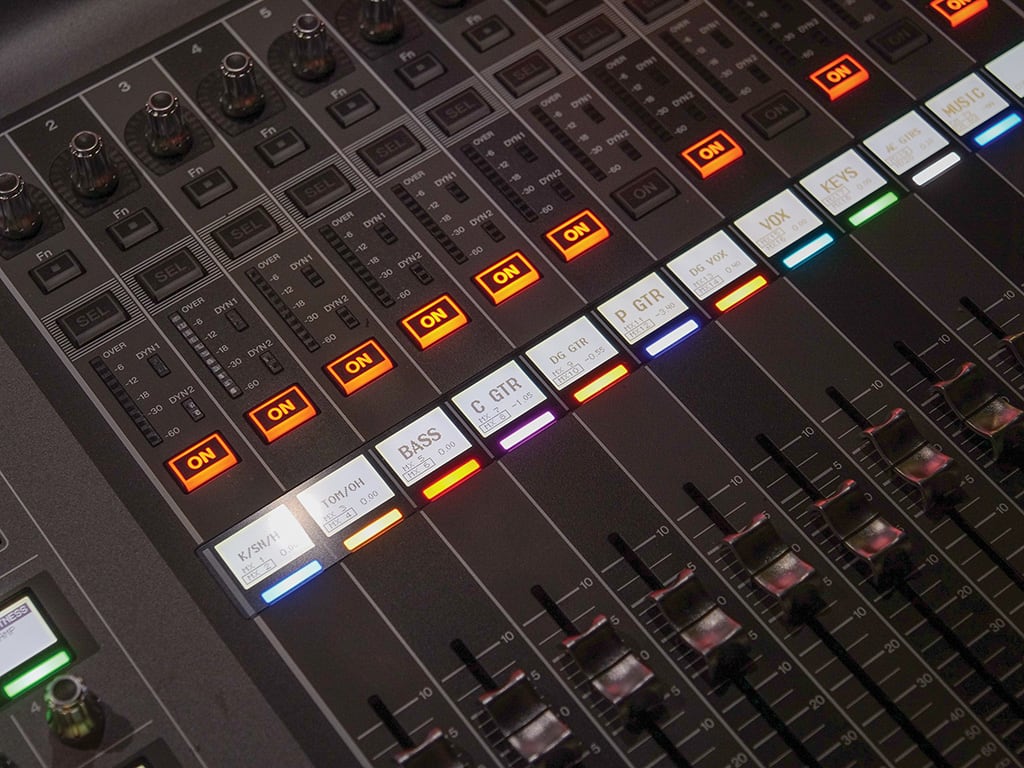
PITCH ISSUES
In Melbourne, the show had a shorter runway than normal, and the FOH tent was 10 feet closer to the stage than it usually is, because of the fresh cricket pitch underfoot. Worthen says it’s a noticeable difference, it puts him closer to the stage volume, which includes “wedges and side fills on stun, plus I’ve got Pat’s guitar right down my throat. The 10 feet also makes a big difference in terms of hearing the stereo image. Further back I’m hearing both sides, versus more of one side than the other.
Worthen is used to doing his best with loud bands. He tries to keep the level around 102dB at FOH, with a gradual increase in level throughout the show. “There are certain songs where I throttle it and bring it back. Depending on how Dave writes out the setlist. It’s not the same every night and not one song sounds the same either.” Outside of stadiums, the stage volume, combined with strict noise limits can be a problem. “In Athens, at the Acropolis, the dB limit is so ridiculously low. My stage volume was 6dB over the limit, and I hadn’t even turned the PA on!”
During the set, Grohl does a couple of numbers out at the tip of the runway, including the beginning of crowd favourite, My Hero. However, probably the biggest change is the part in the show where the video diamond comes down to create a ceiling over the band. “It’s supposed to emulate being back in a shitty little punk rock club,” said Worthen. “Because the roof gets so low over the drums, it changes their dynamic and the bleed down Dave’s vocals, because the drum riser comes forward. The whole thing gets smaller. I move things around, and bring the guitars up so it kind of sounds like it’s back in a club again. It’s different every night and he doesn’t necessarily play the same songs. I just feel it out when that ceiling comes down.
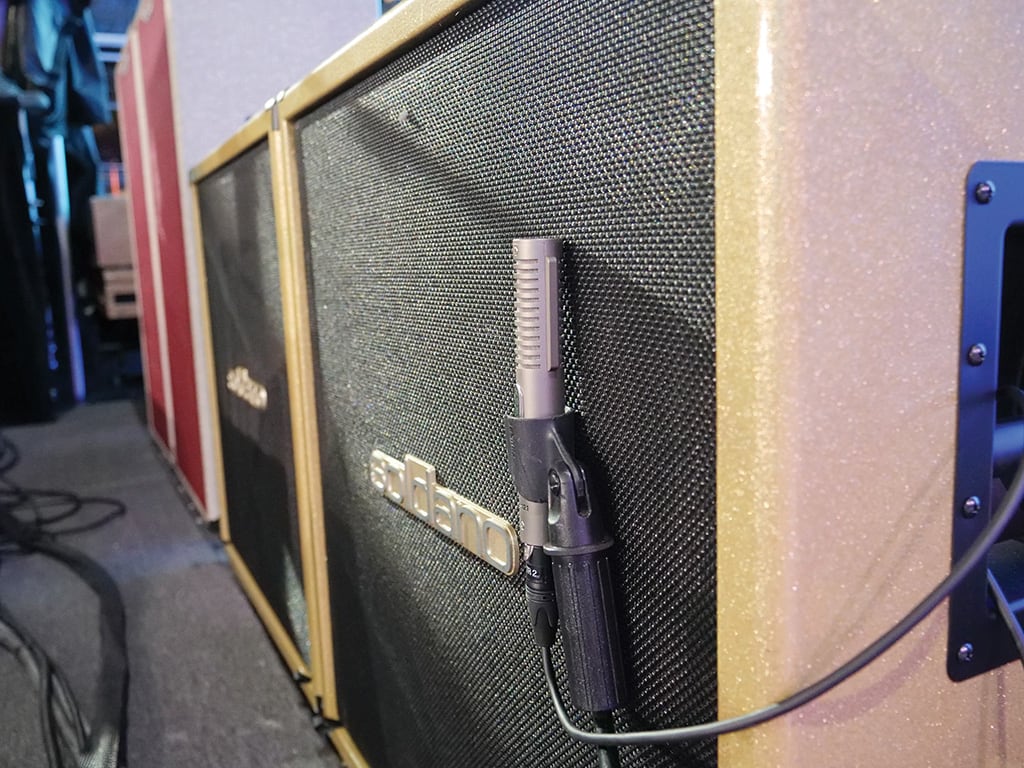
“Some people say I’m an emotional mixer. I mix based off the vibe coming from the band, which is true. If they’re on fire, then I mix them like they’re on fire. If they’re being sloppy, I try to fix it as best I can… but you can’t fix sloppy. I’m constantly thinking about the space. I don’t mix for myself. I mix with people who buy tickets in mind. How would I want to hear it if I came to this show? I’m constantly looking up in the high seats to see if those people are having fun or not. The environment’s not necessarily under my control, but if they’re sitting down pouting or on their phones, then something’s wrong up there.”
All reports so far have been glowing, I don’t think Worthen or the Foo Fighters lost any fans that night. I’m sure they’ll be back to fill more stadiums soon.

















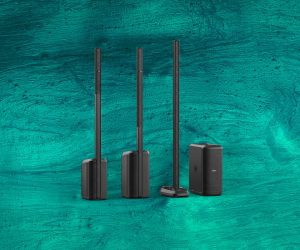


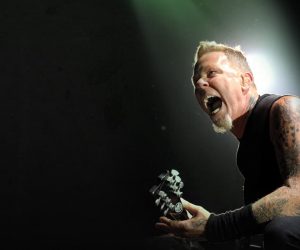





RESPONSES